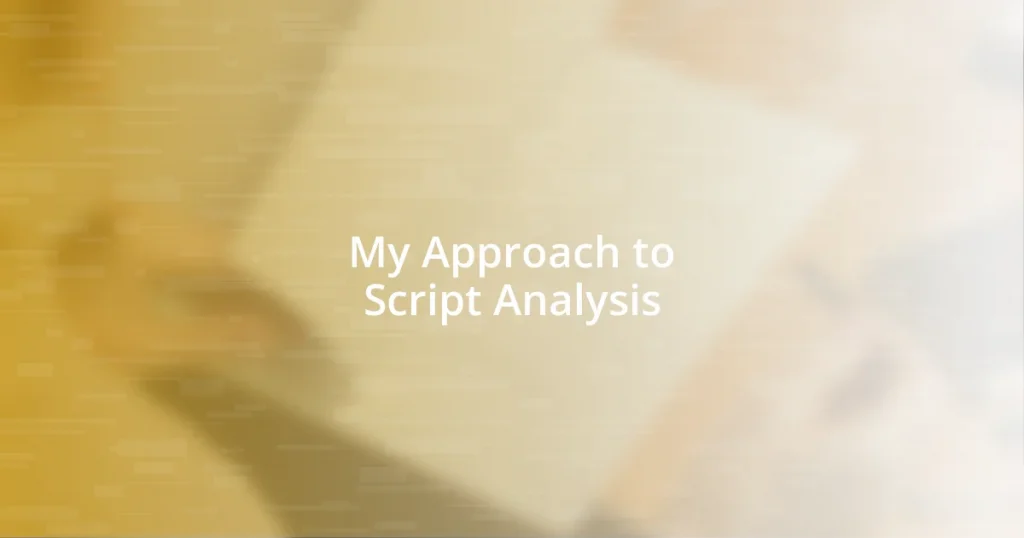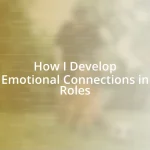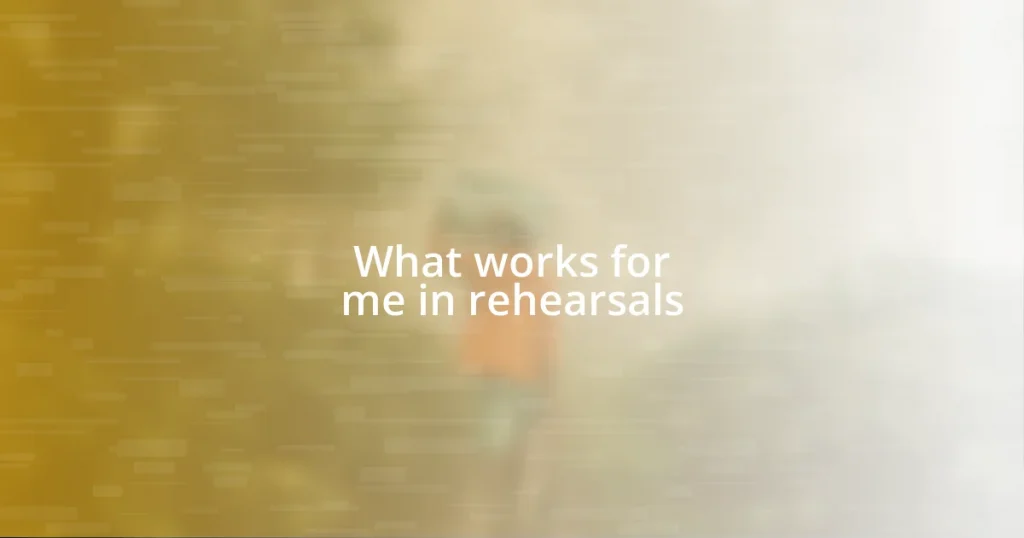Key takeaways:
- Breaking down scripts scene by scene reveals character motivations and thematic developments, enhancing overall narrative understanding.
- Identifying key elements like character development, theme, conflict, and dialogue helps transform a script into a dynamic story.
- Integrating insights from script analysis into performance can elevate emotional delivery, fostering deeper connections between characters and the audience.

Understanding Script Analysis Techniques
When diving into script analysis, I often find myself reflecting on how each character’s journey adds depth to the narrative. One technique I love is breaking down the script scene by scene. It’s like putting together a puzzle—each piece reveals something new about character motivation and thematic development. Have you ever noticed how certain lines can completely change your perception of a character?
Another approach I enjoy is identifying subtext—the underlying messages that aren’t immediately visible. For example, when I analyzed a scene where a character avoids eye contact, it opened up discussions about vulnerability and power dynamics. As I explore these nuances, I can’t help but ask: what do the unspoken moments in a script reveal about the relationship between characters?
Additionally, I’ve always found value in examining a script’s structure. The way it’s organized often reflects the emotional arc of the story. It reminds me of a personal workshop experience where we dissected the three-act structure. It was fascinating to see how tension builds and resolves, leading to an emotional payoff. Do you ever think about how a script’s architecture can influence audience engagement?

Identifying Key Elements in Scripts
Identifying the key elements in scripts is essential for a thorough analysis. I often start by focusing on character arcs, as they serve as the backbone of a good story. For instance, while working on a project with a friend, we discovered how a seemingly minor character’s evolution affected the protagonist’s journey, creating a more intricate narrative.
Here are some key elements to look for when identifying crucial components within the script:
- Character Development: Pay attention to how characters change throughout the story. What challenges do they face that lead to growth?
- Theme: Reflect on the central message or moral of the story. How does it manifest through characters’ actions and dialogues?
- Conflict: Identify the main conflicts—internal and external—that drive the plot. What stakes are raised?
- Setting: Consider how the environment impacts the narrative. Does the setting contribute to the overall mood or themes?
- Dialogue: Analyze how conversations reveal character relationships and provide insight into motivations. What can be understood beyond the spoken words?
In my experience, focusing on these elements transforms the script into a living, breathing story. I vividly remember reading a script that seemed straightforward at first, but once I dove deeper, I noticed subtle conflicts that enriched the characters’ motivations. Those layers made the story all the more compelling and served as a reminder of the beauty hidden within a well-crafted narrative.

Evaluating Character Development
Evaluating character development is crucial in script analysis. In my own work, I once analyzed a character who, at first glance, appeared quite one-dimensional. However, the deeper I went into their choices and relationships, the more I saw shades of complexity. This character’s small victories and failures transformed how I viewed not only them but also the impact on the overall narrative.
I find that marking key moments of change is incredibly helpful. For instance, during one of my recent workshops, we examined how characters react to significant events—like loss or betrayal. A character’s response to these moments often reveals their fundamental beliefs and fears. Aren’t those revelations fascinating? They can completely redefine the audience’s understanding of who the character really is.
Lastly, examining the interactions between characters can unveil hidden depths. I remember a scene where two characters shared a seemingly mundane conversation, but digging into the subtext revealed layers of history and unspoken conflict. This added context made their relationship far richer and more relatable. It’s these intricate details that keep me engaged and often encourage me to reflect on my experiences as well.
| Aspect | Example |
|---|---|
| Character Arcs | Transformation of a protagonist facing a moral dilemma |
| Dialogue Subtext | Two characters discussing the weather while harboring resentment |

Analyzing Plot Structure and Arcs
When I dig into a script, analyzing the plot structure and arcs always captivates my attention. I can’t help but feel excited diving into the various beats and shifts in a story. One project I worked on had a plot twist that flipped the entire narrative on its head. It got me thinking—how do these plot developments resonate with the audience? They not only serve to propel the story forward but also elicit emotional reactions, making the experience unforgettable.
Understanding the different stages of a plot arc can reveal so much about the storyteller’s intentions. For instance, looking at the classic structure—exposition, rising action, climax, falling action, and resolution—allows me to map out where the emotional peaks and valleys lie. I remember analyzing a dramatic scene where the protagonist faced their greatest fear; that moment was the crescendo of the story. Wouldn’t you agree that recognizing these emotional high points can completely alter our response to the narrative?
Transitions between these arcs are equally fascinating. I often reflect on how a character’s journey through conflict builds anticipation and complicates their relationships. In one story I dissected, the protagonist’s journey was riddled with personal failures, creating an authenticity that resonated deeply with me. Why does that emotional honesty matter? Because it makes us root for the character’s success. Plot structure isn’t just about events; it’s about the emotional stakes that draw us in and keep us invested.

Examining Dialogue and Subtext
Examining dialogue and subtext is like peeling back layers of an onion. I recall a scene from a script where two friends were discussing dinner plans, yet their words dripped with underlying tension and unspoken grudges. It got me thinking—how often do we disguise our true feelings behind casual chatter? Those subtle cues make dialogue compelling, transforming mundane exchanges into rich emotional landscapes.
Subtext creates the bridge between what is said and what is truly felt. During one of my script read-throughs, a line that seemed innocuous at first—a simple, “Sure, that works”—felt heavy when I particularly examined the character’s body language and tone. I couldn’t help but wonder: how many truths do we hide under the surface in our everyday conversations? This interplay of verbal and non-verbal communication enriches narratives, allowing the audience to interpret meaning beyond the words themselves.
I find that a character’s choice of dialogue can tell you more than their backstory ever could. In one analysis, I discovered a character who frequently used sarcasm—a defense mechanism that hinted at deeper insecurities. How fascinating is it that a single tone can reveal vulnerabilities? This understanding fosters connection, making me reflect on how we all wield language as a tool, sometimes obscuring what’s really going on in our hearts.

Integrating Themes and Motifs
Integrating themes and motifs in a script can feel like piecing together a jigsaw puzzle. I recall analyzing a project where the recurring motif of an old photograph connected deeply with the protagonist’s memories. This simple element wasn’t just aesthetic; it highlighted their struggle with nostalgia and identity. Have you ever noticed how a single motif can amplify an emotional theme, making the narrative feel more cohesive?
I find that themes often operate like threads woven throughout the story, connecting characters’ experiences and revelations. In one script breakdown, I focused on the theme of redemption, seeing how different characters faced their past mistakes. The way these arcs intersected added layers to the narrative, painting a rich picture of their growth. It prompted me to think—how often do we seek redemption in our own lives? This reflection brings a sense of relatability that makes the audience invest in the characters’ journeys.
Moreover, the interplay between themes and motifs can elevate a script from good to unforgettable. One memorable example for me was a script featuring a recurring winter landscape that mirrored the protagonist’s internal struggle. As the seasons shifted in the narrative, so did the protagonist’s journey towards healing. Isn’t it incredible how visual elements can reinforce emotional themes? This integration invites the audience to see deeper meanings, creating a lingering impact long after the story ends.

Applying Insights to Performance
When it comes to applying insights from script analysis to performance, I often think about how the subtleties of character dynamics can transform a scene. I vividly remember working with an actor on a monologue that felt flat during rehearsals. After diving deep into the character’s motivations and fears, we unearthed an emotional vulnerability that redefined the delivery. Isn’t it fascinating how unlocking one layer of insight can elevate an entire performance?
In another instance, while rehearsing a scene laden with conflict, I encouraged the cast to explore their character’s backstory in depth. It was striking to see how understanding the character’s history influenced their reactions and interactions with each other. Have you ever experienced a moment where a deeper understanding of your role shifted your portrayal entirely? I believe that consciously integrating insights from script analysis into performance creates authenticity and connection, allowing actors to embody their characters more fully.
I’ve also seen how attention to detail, like the rhythm of dialogue, can affect pacing and tension in a scene. During a production, we experimented with varying the delivery speed of key lines based on the underlying emotional stakes. This simple change made the audience lean in, holding their breath in anticipation. Doesn’t it amaze you how small adjustments rooted in analytical insights can leave a lasting impression on the audience? Every decision in performance can either reinforce or undermine the script’s intentions, and I find that awareness becoming a vital part of my approach.















